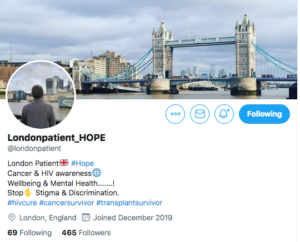His name is Adam Castillejos, but he prefers to be called L.P. when he talks about his journey of illness and healing: L.P., as for London Patient, the public identity he adopted for a year as the second person in the world to be cured of the Human Immunodeficiency Virus (HIV) by a stem cell transplant into his marrow.
On March 10, L.P. decided to reveal his more personal identity. He is Castillejos, Venezuelan, grew up in Caracas, has lived in London since 2002, is of German and Spanish descent, also lived in Copenhagen, turned 40 (which he celebrated on a trip to Machupicchu, Peru) and now wears the length of his black hair down to his shoulders, because with the chemotherapies for his stage 4 lymphoma he lost it several times.
Yes: Castillejos was not only cured of HIV, but also survived cancer. A bone marrow transplant to get rid of the lymphoma worked that double result. The donor of the marrow who received L.P. had a mutation that made it resistant to HIV.
“This is a unique position to be in, a unique and very humbling position,” he said. “I want to be an ambassador of hope,” Castillejos told journalist Apoorva Mandavilli for a New York Times report.
L.P.’s lymphoma ended up not responding to chemotherapy. According to Mandavilli’s report, in the spring of 2015 Castillejos was told by his doctors he would only live until Christmas. The possibility of donating a marrow appeared.
The team in charge of treating the patient chose a donor “who had two copies of a mutation in the CCR5 gene, which gives people resistance to HIV infection”, the scientific journal Nature disclosed on March 5th. According to this journal, about 1% of people of European descent have these characteristics.
In March 2019, Dr. Ravindra Gupta, the University of Cambridge virologist who led the treatment team, announced a cure for Adam Castillejos. The patient had stopped taking antiretroviral pills in October 2017, Mandavilli reports.
“The London patient has been in HIV-1 remission for 30 months with no detectable replication-competent virus in blood, CSF, intestinal tissue, or lymphoid tissue. Donor chimerism has been maintained at 99% in peripheral T cells. We propose that these findings represent HIV-1 cure,” Gupta and the physicians in the team he led write a year later in an article for the renowned British medical journal The Lancet.
After the announcement of his cure, Adam Castillejos did not reveal his full identity. So he became the London Patient, L.P. He opened a twitter account, Londonpatient_HOPE.

In 2008, the Berlin Patient, Timothy Hay Brown, had appeared as the first and only patient to be cured of HIV with a medical condition like Castillejos’ and a bone marrow transplant. L.P. began communicating with Brown on a weekly basis. He was the only person who fully understood what Castillejo was going through.
Professor Ravindra Gupta told BBC News that, indeed, the successful results shown by L.P. are similar to those shown by Brown 12 years ago, but, as it is, it is not a treatment that can be applied to the millions of people with HIV around the world. Therapy with stem cells from donated marrow was initially used to treat cancer patients and is aggressive. Antiretroviral pillsn, the doctor says, have proven effective for HIV. ” It is important to note that this curative treatment is high-risk and only used as a last resort for patients with HIV who also have life-threatening haematological malignancies. Therefore, this is not a treatment that would be offered widely to patients with HIV who are on successful anti-retroviral treatment,” Gupta said.
What these findings do open up is a possibility of finding a cure for HIV with gene therapy.In fact, the days that followed Adam Castillejos bone marrow transplant on May 13, 2016 were very hard. That’s what Mandavilli writes in his report. L.P. spent months in the hospital, vulnerable. He lost more than 70 pounds of weight, underwent several more operations, contracted infections of various kinds, lost a little bit of hearing, his mouth was ulcerated, so the doctors looked for ways to continue giving him his antiretroviral pills.
“One of the doctors came to me and said to me, ‘You must be very special, because I have more than 40 doctors and clinicians discussing your medication,’” Castillejos told the reporter.
When he left the hospital, the only exercise he could do was walking, so he did that for hours in the city of London, Mandavilli writes.
After a year, Castillejos felt stronger. In October 2017, he stopped taking antiretrovirals. He turned 40, made the trip to the Inca archaeological city.
Today Castillejos “exudes good health and cheer”, the journalist reports and he feels ready to tackle the responsibility of being the London Patient, with his name, his surname, his image revealed.
This is a new path for him. That’s what he tweeted on March 9: “Doing my best to try and embrace my new path as an Ambassador of Hope”
He told Mandavilli: “I don’t want people to think, ‘Oh, you’ve been chosen. No, it just happened. I was in the right place, probably at the right time, when it happened.”
